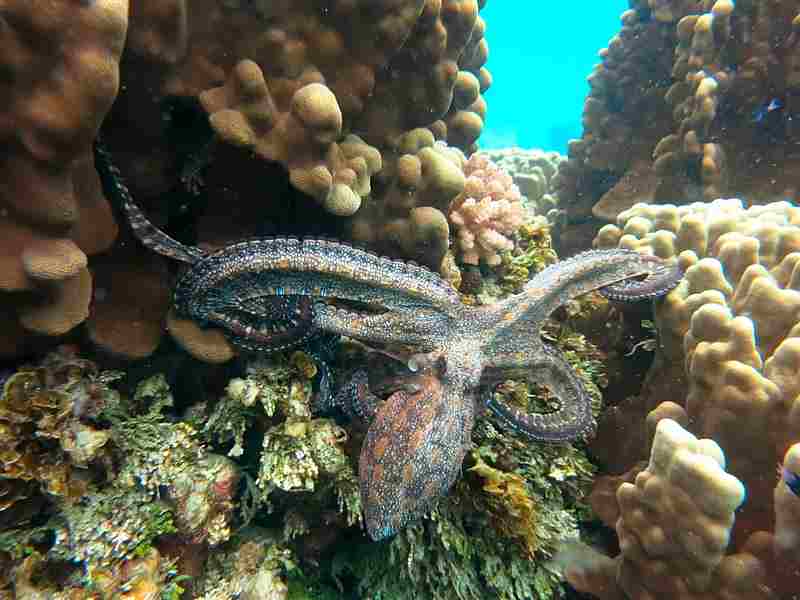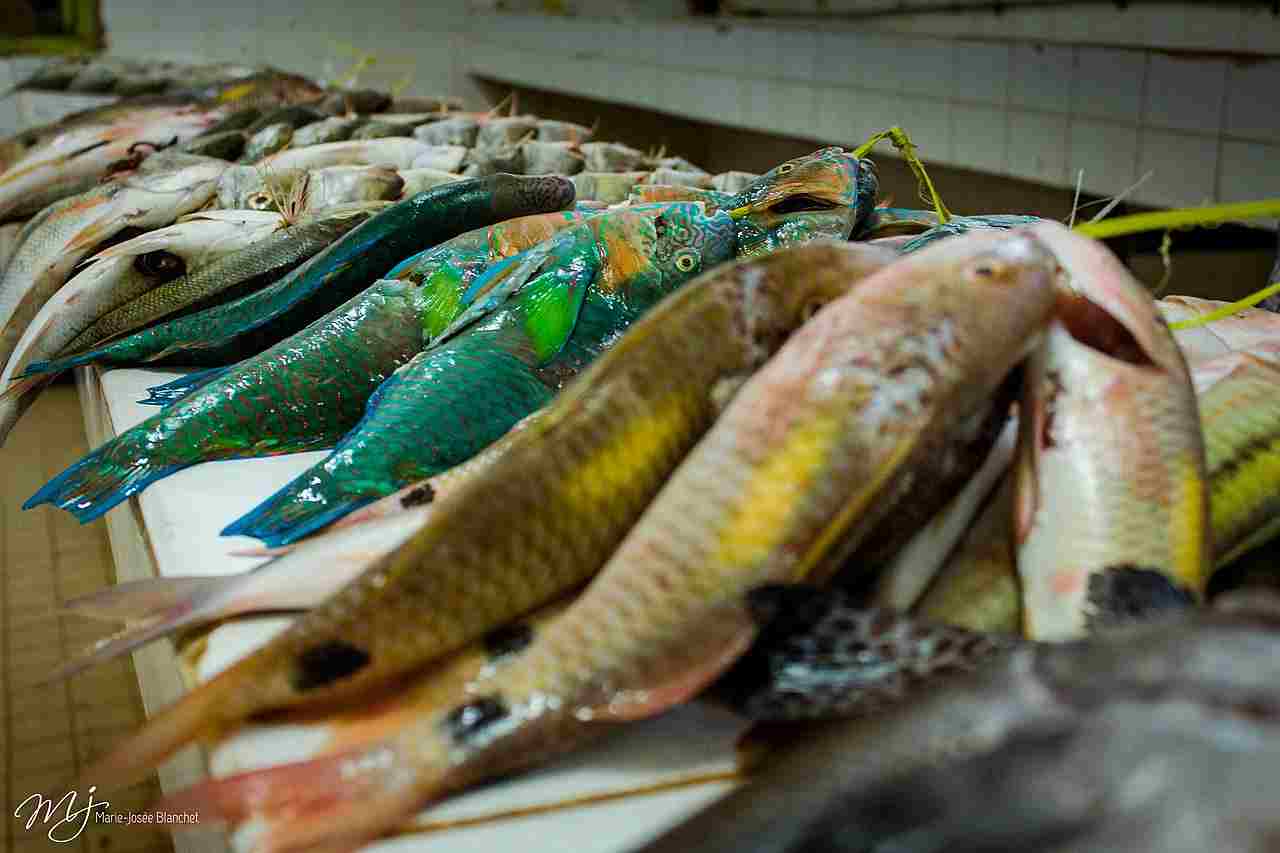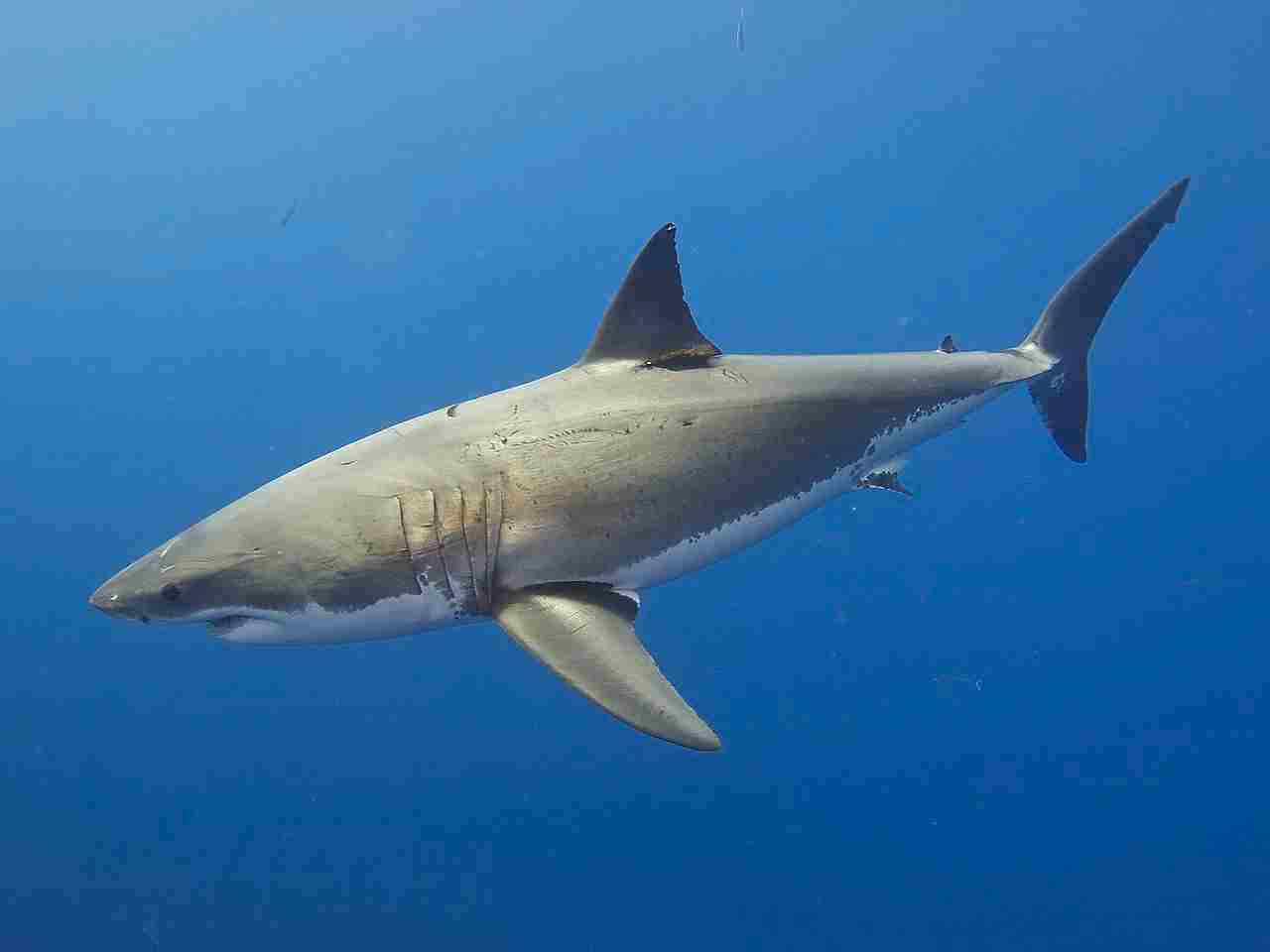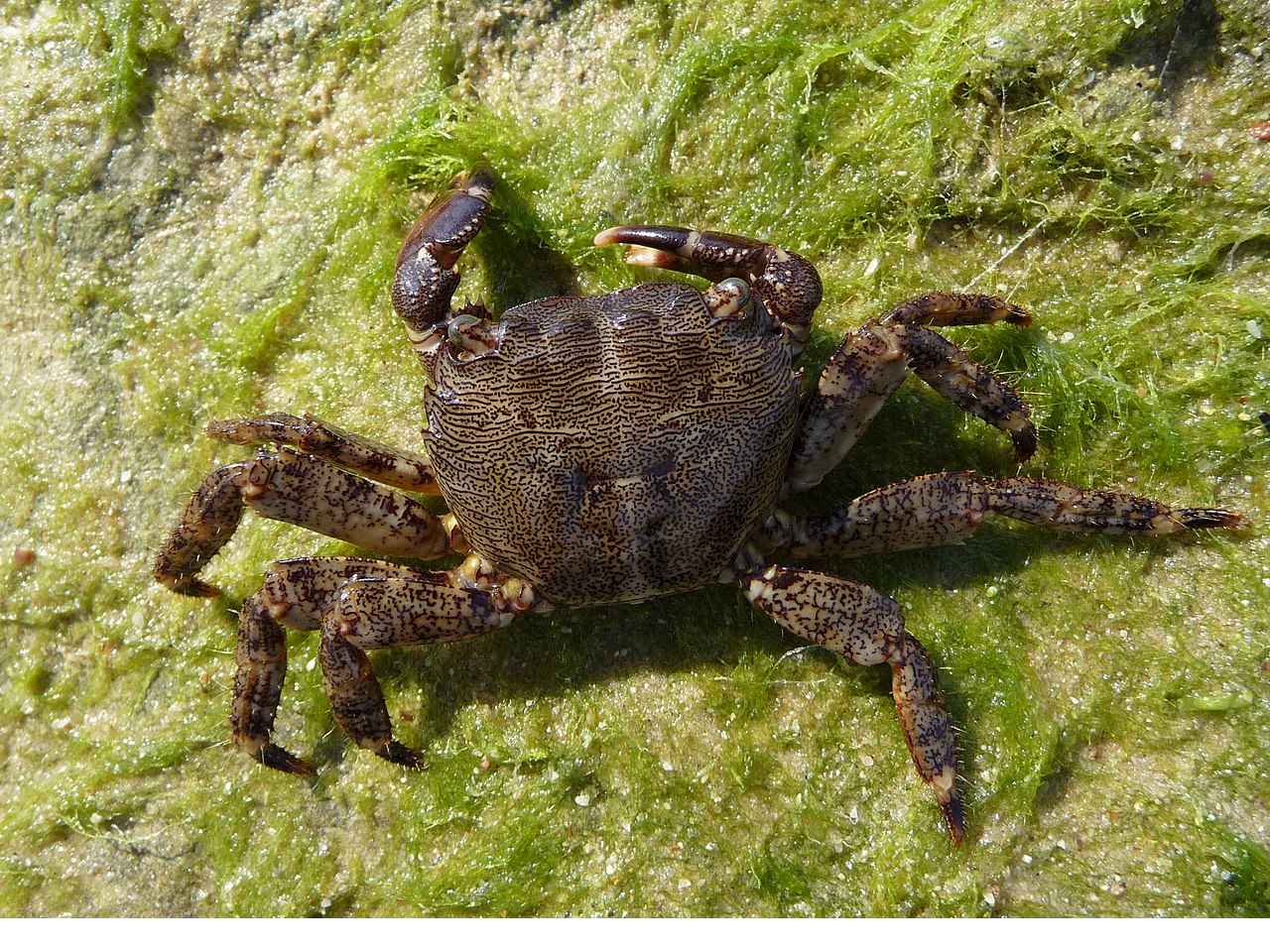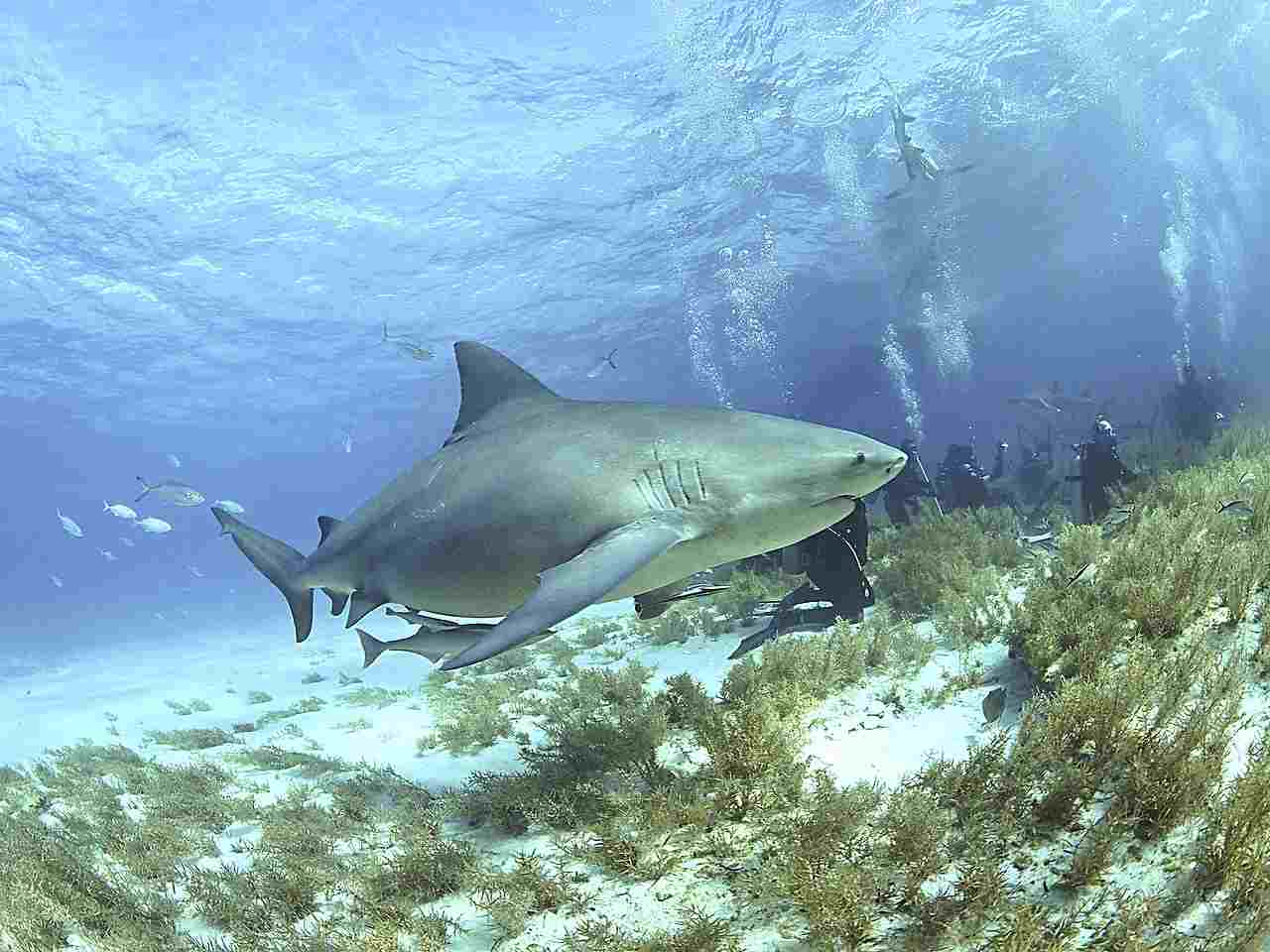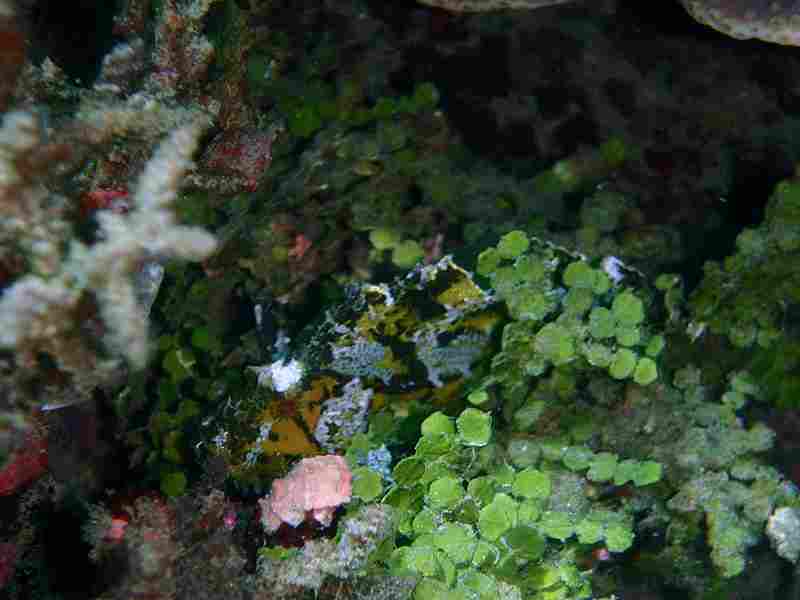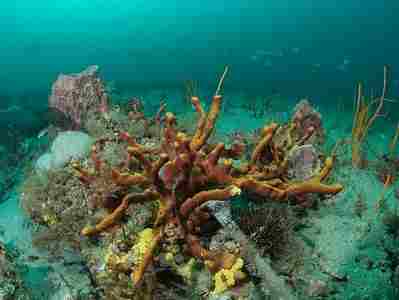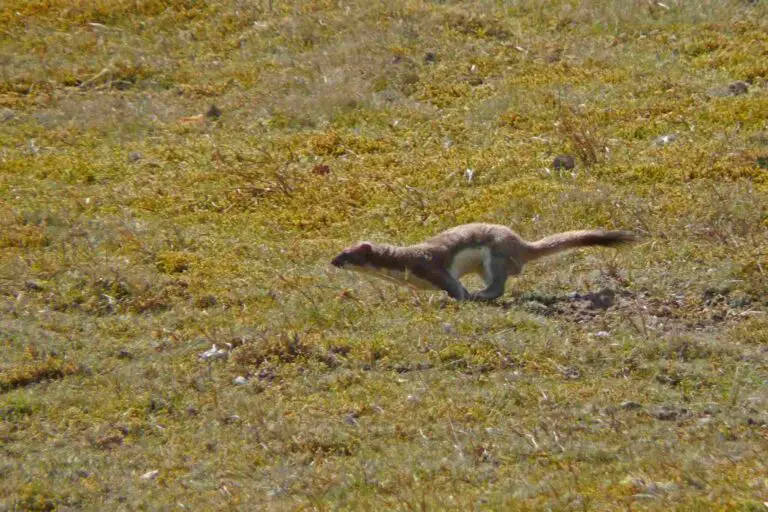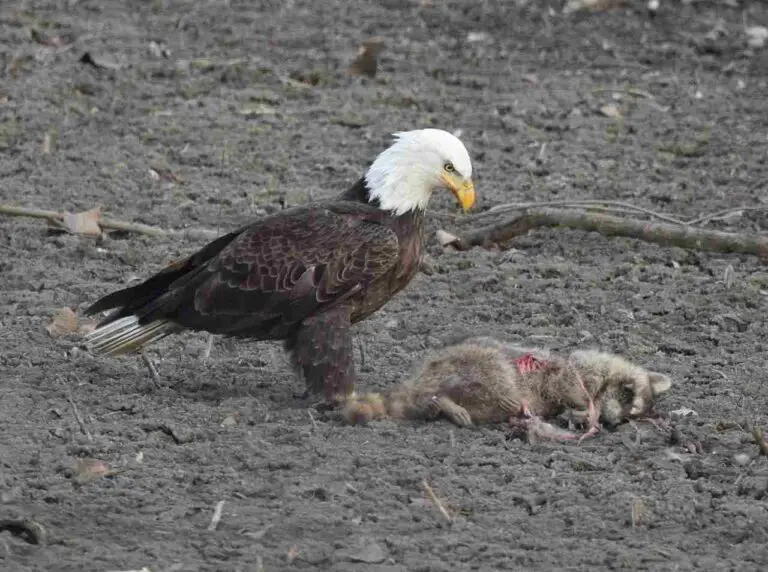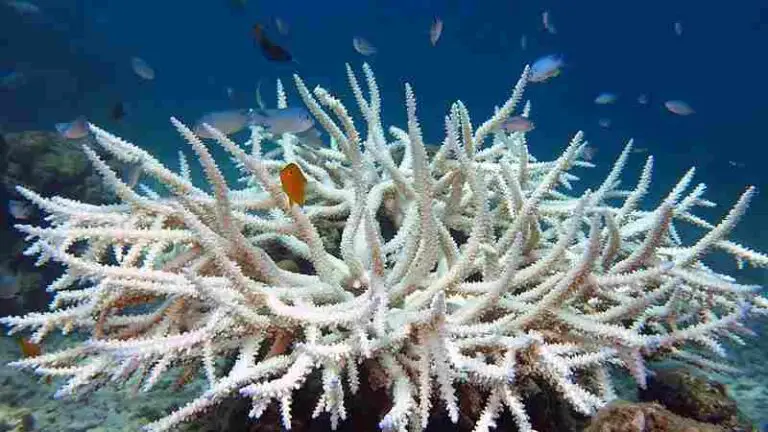5+ Biotic Factors in the Great Barrier Reef and Their Characteristics
Biotic factors in the great barrier reef are; autotrophs like zooxanthellae, seagrasses and macroalgae; herbivores like sea urchin, surgeonfish, parrotfish, green turtle, and rabbitfish; carnivores like groupers, moray eels, octopuses, lionfish, and sharks; omnivores like crabs and damselfish; decomposers like fungi, detritivores, and bacteria; as well as diverse trophic relations between these organic groups.
This article discusses biotic factors in the great barrier reef and their characteristics, as follows;
1). Great Barrier Reef Autotrophs (as one of the Biotic Factors in the Great Barrier Reef)
Autotrophs in the Great Barrier Reef ecosystem, are primary producers that are capable of harnessing solar radiation as a source of energy for the production of biomass and chemical bioenergy, through photosynthesis.
These organisms have an essential role to play in the reef ecosystem, which is to provide food and energy for other (heterotrophic) organisms.
Categories/Examples of Autotrophs in the Great Barrier Reef
The main autotrophs in the Great Barrier Reef include microbial organisms, vascular and non-vascular plants, such as various species of seagrasses, algae, coral-zooxanthellae, and cyanobacteria [5].
*Seagrasses
Seagrasses are a group of autotrophs that occur in the Great Barrier Reef ecosystem.
They can be described as flowering plants that grow in shallow coastal waters, and provide microhabitats for various marine organisms [1].
Seagrasses also contribute to the stabilization of sediments, mitigation of erosion, and improvement of water quality within their environment.

*Algae in the Great Barrier Reef
Algae, including both macroalgae and microalgae, are among the important autotrophs that inhabit the Great Barrier Reef.
Macroalgae, otherwise referred to as seaweeds, occur in the shallow parts of the reef and provide food and microhabitat for many herbivorous and non-herbivorous organisms.
Microalgae, like diatoms and dinoflagellates [6], are at the base of the reef food chain, from where they provide food for heterotrophic organisms.
*Coral-Algae in the Great Barrier Reef
Corals are arguably the most important autotrophs in the reef ecosystem.
They have colonial living arrangements, that usually share a mutualistic relationship with photosynthetic algae known as zooxanthellae [8]. This relationship is why corals can be classified as autotrophs (as they are part of an autotrophic assemblage).
Zooxanthellae inhabit the tissues of corals, and are responsible for providing them with photosynthetically-derived energy.
In return for this energy, the coral provides nutrients and shelter to the zooxanthellae. The symbiotic relationship described is essential for the growth, survival and sustainability of coral reefs.
Summary of Importance, of Autotrophs in the Great Barrier Reef
Autotrophs in the Great Barrier Reef are important for maintaining the species richness, biodiversity and overall health of the ecosystem.
They constitute the foundation of the food chain, by providing nutrients and energy to organisms in higher trophic levels. They also contribute to nutrient recycling, and help sustain the oxygen cycle as well as processes like carbon sequestration, within their environment.
2). Great Barrier Reef Herbivores
Herbivores in the Great Barrier Reef ecosystem, are a group of organisms that feed mainly on autotrophs like coral-zooxanthellae, seagrasses and free-living macro/microalgae.
These organisms are crucial to the evolution and continued modification of the reef ecosystem, due to their role(s) in regulating algal growth, contributing to trophic energy-transfer, and promoting coral health.
Examples of Herbivores in the Great Barrier Reef
The Great Barrier Reef is inhabited by a diverse range of herbivorous organisms, which include; sea urchin, surgeonfish, parrotfish, green turtle, and rabbitfish. Each of these examples is briefly discussed below;
*Sea Urchin
Sea urchins are invertebrates with a spiny morphology, that are known to graze on algae using specialized mouthparts referred to as Aristotle's lantern [4].
They are prominent herbivores in reef environments, and contribute to controlling macroalgal growth.
In some cases, however, overpopulation may occur among sea urchins, leading to overgrazing and damage to the reefs ecosystem.
*Surgeonfish
Surgeonfish, also called tangs; are a group of herbivorous fish that rely on algae as a food source [10].
Their physiological features include a sharp, blade-like spine on their tail, from which they derive their name.
Surgeonfish help in the maintenance of balance between coral and algal populations, and prevent algal overgrowth while promoting coral health.

*Parrotfish
Parrotfish are herbivorous, colorful fish that graze on coral polyps and algae (which grow on the surfaces of these polyps).
They possess specialized, beak-like teeth which they use for scraping off algae from the reef substrate.
Parrotfish are also involved in bioerosion, because their feeding activities on coral reefs contribute to the breakdown of dead coral, and facilitate new coral growth [2].
*Green Turtle
Green turtles are important herbivores in the Great Barrier Reef.
They feed mainly on algae (micro, macro) and seagrasses, and their foraging activities promote autotroph regeneration, while maintaining the health of seagrass beds.
Green turtles are often regarded as keystone species in the reef biome, because of their immense ecological influence over seagrass microhabitats.
*Rabbitfish as Autotrophs in the Great Barrier Reef
Rabbitfish are small herbivorous fish that consume seagrasses, algae, and in some cases, small invertebrates as well [9].
While this implies that they can be omnivorous, rabbitfish are discussed here as herbivores because of their heavy reliance on algal and plant matter as primary food sources.
They are involved in controlling algal growth on reefs and are distinguished by their protruding mouth structures which are comparable to a rabbit's mouth, and used to browse on algae.
Summary of Importance of Herbivores in the Great Barrier Reef
Herbivores help in maintaining the delicate balance that occurs between autotrophic and heterotrophic groups, in the Great Barrier Reef.
By consuming seagrasses, algae, and controlling their growth, they help create space for progressive growth and development of coral structures, thereby contributing to ecological resilience of the entire ecosystem.
3). Great Barrier Reef Carnivores (as one of the Biotic Factors in the Great Barrier Reef)
Carnivores in the Great Barrier Reef ecosystem, are organisms that feed mainly on other consumers, including invertebrates and small fish.
Thee organisms play a role in maintaining the health and balance of the reef ecosystem, by regulating the populations of prey species, and contributing to overall biodiversity.
Examples of Carnivores in the Great Barrier Reef
Some examples of carnivores in the Great Barrier Reef are; groupers, moray eels, octopuses, lionfish, and sharks.
*Groupers
Groupers are large predatory fish that consume crustaceans, mollusks, and smaller fish.
Some species are capable of engulfing and swallowing their prey whole, using their powerful jaws and large mouths.
Groupers are relatively-prominent predators in the reef ecosystem, and help regulate smaller fish populations.
*Moray Eels
The moray eel is an ambush predator that conceals itself in crevices within the coral reef structure, and preys on crustaceans as well as smaller fish.
Moray eels possess elongate, serpentine bodies, sharp teeth and strong jaws, which they use to capture and consume prey.
*Sharks
The Great Barrier Reef plays host to various species of sharks, including reef sharks and larger groups like white sharks and tiger sharks.
They exert a top-down regulatory effect on the food chain/energy pyramid, by consuming a relatively-wide range of invertebrates and fish, thereby helping to maintain ecological balance.
*Octopuses
Octopuses are a group of highly intelligent predatory animals that inhabit reef environments.
They possess tentacles and strong beak structures, which they use for prey capture and consumption (their prey often includes mollusks, crustaceans and small fish).
Octopuses have evolved multiple prey-capture strategies, and can be described as skilled hunters.

*Lionfish in the Great Barrier Reef
Lionfish occur as an invasive species in the Great Barrier Reef, but have also become significant predators.
They are equipped with venomous spines, and efficiently hunt their prey, which include invertebrates and small fish.
Their presence in the ecosystem often has a negative effect on native fish populations.
Predator-Prey Relationships and Dynamics in the Great Barrier Reef
Predator-prey relationships in the Great Barrier Reef are generally complex and diverse.
An example of these relationships is that which exists between reef sharks and their prey such as invertebrates and smaller fish.
Another is the tendency of groupers to feed on crustaceans and herbivorous fish.
Moray eels hunt crustaceans and smaller fish from their hiding place in substrate-crevices.
Lionfish target mainly invertebrates and small fish, while octopuses feed on a relatively broad range of prey.
These predator-prey dynamics are important for the maintenance of ecological balance in the reef ecosystem.
Predators help regulate prey-specie populations, thereby preventing/mitigating processes of resource-depletion like overgrazing, and facilitating the reproduction and survival of diverse organisms.
4). Great Barrier Reef Omnivores
Omnivores in the Great Barrier Reef ecosystem, are organisms that have a flexible and versatile diet, comprising both animal and plant matter.
They are also versatile in their role(s) in the ecosystem, because they can influence the abundance of a variety of organic groups or food sources, including seagrasses, invertebrates, small fish, and algae.
Examples of Omnivores in the Great Barrier Reef
Some examples of omnivores in the Great Barrier Reef are; crabs and damselfish. Other organisms that are mostly herbivorous; like surgeonfish and parrotfish, can also occasionally exhibit omnivorous behavior.
*Crabs as Great Barrier Reef Omnivores
Some species of crabs in the Great Barrier Reef are classified as omnivorous, and consume a variety of food sources.
They have scavenging habits, and feed on organic litter, while also capturing small invertebrates and grazing on algae.
Crabs have an important role to play in the recycling of nutrients, and contribute to the biodegradation of organic matter.

*Damselfish
Damselfish are a group of territorial, small fish that can occur in the reef ecosystem.
While their diet comprises primarily of zooplankton and algae, damselfish can also prey on fish eggs, and consume small invertebrates among other food sources.
They have a diverse diet that includes both animal and plant matter.
*Surgeonfish and Parrotfish as Omnivores in the Great Barrier Reef
Surgeonfish and parrotfish can also be categorized as omnivores due to their ability to consume non-autotrophic matter from invertebrates, as part of their diet.
Summary of Importance of Omnivores as Biotic Factors in the Great Barrier Reef
Omnivores in the Great Barrier Reef are important due to their contribution to overall ecological balance in their habitat, by consuming both animal and plant matter.
They help to regulate growth of primary producers (like algae) through their grazing activities, thereby preventing harmful, excessive competition and maintaining the health of the reef.
Their feeding habits also facilitate energy-flow and nutrient cycling within the ecosystem.
5). Great Barrier Reef Decomposers (as one of the Biotic Factors in the Great Barrier Reef)
Decomposers in the Great Barrier Reef ecosystem, are organisms that help break down organic materials, such as animal waste and dead-organism remains, into simpler substances.
They play a determinant role in the decomposition process and in nutrient recycling within the reef ecosystem.
Examples of Decomposers in the Great Barrier Reef
Some examples of decomposers in the Great Barrier Reef are; fungi, detritivores, and bacteria. Each of these groups is briefly discussed.
*Fungi in the Great Barrier Reef
Fungi are important decomposers in the Great Barrier Reef.
Their activities help break down organic matter, with the use of enzymes that convert complex organic compounds into simpler products [7].
Fungi help in the decomposition of remains of algae and corals, among other organic materials.
*Great Barrier Reef Detritivores
Detritivores, like some species of crustaceans and worms, also play roles in the decomposition process.
They feed on organic materials, causing them to breakdown into smaller particles, and accelerating the biodegradation process.
*Bacteria
Bacteria are arguably the most important decomposers in the reef biome.
They break down organic materials into their elemental constituents, and play a vital role in nutrient recycling through the resultant release of essential elements such as phosphorus and nitrogen back into the water, to become available for uptake by other organisms.
Summary of The Importance of Decomposers as Biotic Factors in the Great Barrier Reef Ecosystem
The role of decomposers in the Great Barrier Reef is an important one, which involves maintaining the functionality and health of the ecosystem.
They help in recycling nutrients by breaking down organic matter, so that essential elements are released back into the environment.
This process of recycling ensures that nutrients are continually available for primary producers and other dependent organisms in the food chain.
Decomposers also help maintain water quality in the Great Barrier Reef, by breaking down organic waste materials, and preventing the accumulation of potentially-toxic, decaying matter.
This prevents the release of toxins into the surrounding environment.
Trophic Relations in the Great Barrier Reef
Trophic relations in the Great Barrier Reef refer to energy-transfer dynamics and feeding relationships occurring among different organisms in the ecosystem.
These relations can be summarized into distinct trophic levels that represent different positions in the food chain or energy-flow hierarchy.
Trophic levels in the Great Barrier Reef include; producers (level 1), primary consumers (level 2), secondary consumers (level 3), and tertiary consumers (level 4).
*Producers in the Great Barrier Reef
These organisms are the primary producers in the reef ecosystem, and mainly include photosynthetic organisms like macroalgae, coral zooxanthellae, and seagrasses.
They are responsible for converting solar energy into chemical energy and organic matter through the process of photosynthesis.
*Primary Consumers in the Great Barrier Reef
These are herbivorous organisms that directly feed on the producers.
In the Great Barrier Reef, primary consumers/herbivores include marine snails, sea urchins, and various species of herbivorous fish, which graze on seagrasses and algae.
*Secondary Consumers in the Great Barrier Reef
These are carnivorous consumers that prey mainly on the primary consumers.
Examples include some cephalopods and crustaceans, as well as species of predatory fish like snappers and groupers, which consume invertebrates and small fish.
*Tertiary Consumers in the Great Barrier Reef
These are the apex predators that usually occupy the topmost trophic level in the ecosystem, and feed on both primary and secondary consumers.
Examples of tertiary consumers in the Great Barrier Reef are; sharks, other large predatory fish species, as well as some marine reptiles.
Symbiotic Relations in the Great Barrier Reef
In addition to trophic relations in the Great Barrier Reef, various symbiotic relationships also occur. Below are three notable examples;
*Coral-Zooxanthellae Symbiosis
As earlier stated, corals in the Great Barrier Reef share a symbiotic relationship with photosynthetic algae known as zooxanthellae.
The algae provide nutrients to the corals through photosynthesis, while in return the corals offer shelter and access to underwater-light from the Sun.
*Clownfish-Anemone Mutualistic Relationship
Clownfish often live in a symbiotic arrangement with sea anemones [11].
The clownfish are protected from predators by the stinging tentacles of the anemone, and in return, they provide leftover food and may defend the anemone from potential intruders.
*Cleaner Fish-Host Mutualism/Symbiosis
Cleaner fish, like cleaner wrasses, share mutualistic relationships with larger fish in their habitat by removing dead epidermis and parasites from their bodies [3].
In turn, the cleaner fish gain a source of food, as the host fish benefits from improved hygiene with the removal of parasites.
Summary of Trophic Relationships in the Great Barrier Reef
Relationships between animals in the Great Barrier Reef can vary from one form to another.
They include competition for resources, mutualistic symbiosis, and predator-prey interactions.
These interactions contribute to ecological stability and biodiversity of the reef ecosystem.
Conclusion
Biotic factors in the great barrier reef are;
1. Great Barier Reef Autotrophs like zooxanthellae, seagrasses and macroalgae
2. Great Barrier Reef Herbivores like sea urchin, surgeonfish, parrotfish, green turtle, and rabbitfish
3. Great Barrier Reef Carnivores like groupers, moray eels, octopuses, lionfish, and sharks
4. Great Barrier Reef Omnivores like crabs and damselfish
5. Great Barrier Reef Decomposers like fungi, detritivores, and bacteria
... and Trophic Relations in the Great Barrier Reef
References
1). Aji, L. P.; Widyastuti, A. (2019). "The condition and composition of seagrass and mollusca on Biak island, Papua." IOP Conference Series Earth and Environmental Science 404(1):012069. Available at: https://doi.org/10.1088/1755-1315/404/1/012069. (Accessed 19 July 2023).
2). Bellwood, D. R. (1995). "Carbonate transport and within-reef patterns of bioerosion and sediment release by parrotfishes (family Scaridae) on the Great Barrier Reef." Marine Ecology Progress Series 117(1-3):127-136. Available at: https://doi.org/10.3354/meps117127. (Accessed 19 July 2023).
3). Bshary, R.; Grutter, A. S. (2002). "Parasite distribution on client reef fish determines cleaner fish foraging patterns." Marine Ecology Progress Series 235. Available at: https://doi.org/10.3354/meps235217. (Accessed 19 July 2023).
4). Candia, D.; Wilkie, I.; Lucca, E.; Andrietti, F.; Melone, G. (1993). "The Aristotle's lantern of the sea-urchin Stylocidaris affinis (Echinoida, Cidaridae): functional morphology of the musculo-skeletal system." Zoomorphology 113(3):173-189. Available at: https://doi.org/10.1007/BF00394858. (Accessed 19 July 2023).
5). Charpy, L.; Casareto, B. E.; Langlade, M. J.; Yoshimi, S. (2012). "Cyanobacteria in Coral Reef Ecosystems: A Review." Journal of Marine Sciences. Available at: https://doi.org/10.1155/2012/259571. (Accessed 19 July 2023).
6). Hinder, S. L.; Hays, G. C.; Edwards, M.; Roberts, E. C.; Walne, A. W.; Gravenor, M. (2012). "Changes in marine dinoflagellate and diatom abundance under climate change." Nature Climate Change 2(4):271-275. Available at: https://doi.org/10.1038/nclimate1388. (Accessed 19 July 2023).
7). Kannan, B.; Ramasamy, K. P.; Manohar, C.-S.; Meena, R. M. (2017). "Diversity and decolorization potential of fungi isolated from the coral reef regions off Kavaratti, India." Indian Journal of Geo-Marine Sciences 46(03):497-503. Available at: https://nopr.niscpr.res.in/handle/123456789/40812. (Accessed 19 July 2023).
8). Karako, S.; Stambler, N.; Dubinsky, Z. (2004). "The Taxonomy and Evolution of the Zooxanthellae-Coral Symbiosis." Symbiosis (pp.539-557). Available at: https://doi.org/10.1007/0-306-48173-1_34. (Accessed 19 July 2023).
9). Macusi, E. D.; Masagnay, N. T.; Nallos, I. M. (2023). "Effects of fish herbivory on seagrass meadows of Guang-guang, Mati City, Philippines." Available at: https://doi.org/10.47193/mafis.3632023010902. (Accessed 19 July 2023).
10). Marshell, A.; Mumby, P. J. (2015). "The role of surgeonfish (Acanthuridae) in maintaining algal turf biomass on coral reefs." Journal of Experimental Marine Biology and Ecology 473:152-160. Available at: https://doi.org/10.1016/j.jembe.2015.09.002. (Accessed 19 July 2023).
11). Roux, N.; Lami, R.; Salis, P.; Magré, K.; Romans, P.; Masanet, P.; Lecchini, D.; Laudet; V. (2019). "Sea anemone and clownfish microbiota diversity and variation during the initial steps of symbiosis." Springer Nature, Scientific Reports 9(1):19491. Available at: https://doi.org/10.1038/s41598-019-55756-w. (Accessed 19 July 2023).
